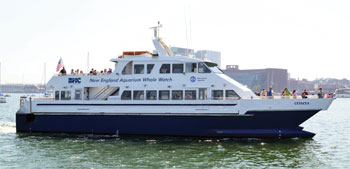A high-speed catamaran ferry became stranded twice this summer, with one incident requiring passengers and crew to stay on the vessel overnight.
Boston Harbor Cruises operates the 83-foot Cetacea as a ferry and excursion vessel. The Coast Guard is still investigating the July stranding and a grounding that occurred in August near Lynn, Mass., according to a spokesman for Sector Boston.
The first incident occurred at about 1600 hours July 28 during a whale-watch cruise with 157 passengers and six crew on board. The vessel was about 14 miles off Salem, Mass., and preparing to return to shore when a submerged cable wrapped around its port propeller, disabling it.
Coast Guard Petty Officer Ross Ruddell said a 7-inch-thick synthetic cable that runs from a surface buoy to a liquefied natural gas (LNG) line on the seabed caught around the propeller.
“There are these LNG lines that run along the ocean floor and there are these other lines that keep these lines in place through a buoy,” Ruddell said. “It was that type of line.”
Cetacea was traveling in restricted waters, which are clearly marked on charts and closed to marine traffic, when the accident occurred.
It is not clear why the vessel was in those waters. A joint investigation into the incident by the Coast Guard and the local harbormaster will likely explore that question, Ruddell said.
Boston Harbor Cruises sent a response team to Cetacea shortly after it became stuck. Divers with hand cutting tools were dispatched to the vessel, although they couldn’t remove the cable.
Meanwhile, initial plans to transfer passengers and crew from Cetacea to another Boston Harbor Cruises vessel were abandoned as night approached. Passengers were given food, water and blankets, and stayed on the vessel overnight.
“It wasn’t that (a transfer) was unsafe. It was just that there was no need to unnecessarily put those people at risk by transferring them off the vessel,” Ruddell said.
Weather conditions at the scene included 2-foot seas and 11-knot winds, according to the Coast Guard.
Specialized dive teams from the vessels Bunker Hill and Scarlett Isabella with heavy-duty cutting equipment removed the cable at about 0520 on the morning after the stranding. Cetacea returned to Long Wharf in Boston under Coast Guard escort about three hours later.
The vessel sustained less than $5,000 in damage, according to the company. Repair costs included hauling and propeller replacement.
Boston Harbor Cruises acknowledged in a statement issued shortly after the accident that the vessel became entangled “within a regulated management area.”
The second accident occurred at about 2020 on Aug. 27 near Lynn, Mass. Cetacea was carrying 10 passengers and four crewmembers when it ran aground roughly 1,500 feet from the pier.
The vessel was inbound to Lynn from Boston and sailing within the navigation channel when it grounded on the sandy bottom, Ruddell said. The accident occurred during the peak of low tide and its cause remains under investigation.
That investigation likely will consider how a shallow-draft vessel such as Cetacea could run aground while traveling within the channel, he said.
Boston Harbor Cruises, which is the largest passenger vessel operator in New England, said in a statement that the captain involved in the grounding had a perfect safety record. It was not the same captain involved in the earlier incident.
The company called the accident “unfortunate and embarrassing” but was thankful nobody got hurt.
Cetacea refloated about 80 minutes after the grounding as the tide rose.

